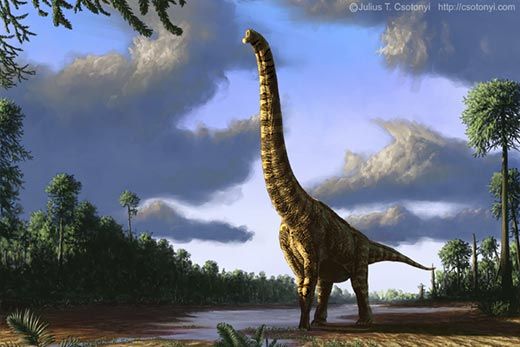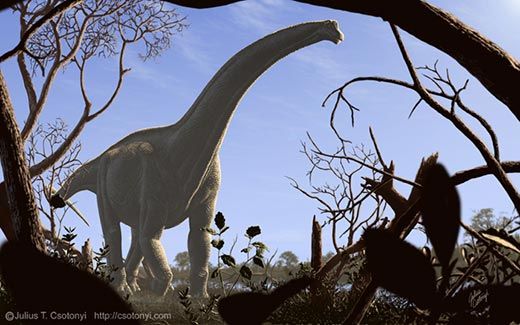How to Build a Giant Dinosaur
Sauropods were humongous creatures, but how they got so large is a mystery that paleontologists are still trying to unravel
/https://tf-cmsv2-smithsonianmag-media.s3.amazonaws.com/filer/Sauropods-Futalognkosaurus-631.jpg)
They were the most gigantic animals ever to walk the earth. Sauropod dinosaurs—“thin at one end; much, much thicker in the middle; and then thin again at the far end,” as comedian John Cleese described them—were titans that thrived for more than 130 million years. The largest known species, such as Argentinosaurus and Futalognkosaurus from prehistoric South America, stretched more than 100 feet long and weighed in excess of 70 tons. Bones found in the 1870s (and since somehow lost) hint that an enigmatic species dubbed Amphicoelias may have been even bigger still.
No land mammal has ever come close to the size of these gargantuan dinosaurs. The prehistoric hornless rhino Paraceratherium—the largest land mammal ever—was a mere 40 feet long and weighed a paltry 17 tons, and today’s African bush elephants, at 5 tons, would look dainty next to the largest sauropod dinosaurs. (Blue whales, at 100 feet and 200 tons, are a bit more massive than sauropods, but it’s easier, physiologically, to be large in an aquatic environment.)
What was it about these dinosaurs that allowed them to become the biggest terrestrial animals of all time? Paleontologists have been puzzling over the question for more than a century. Even relatively modest-sized giants such as Apatosaurus and Diplodocus, early naturalists believed, were so huge that they must have been confined to rivers and lakes deep enough to support the dinosaurs’ bulk. On land, the argument went, these dinosaurs would collapse under their own weight. By the 1970s, skeletal evidence and preserved footprints in trackways confirmed that sauropods were land-dwellers. But it has only been recently that paleontologists have been able to start unlocking the secrets of how these seemingly improbable animals developed over their lifetimes and how they evolved in the first place.
Understanding the natural history of sauropods has been crucial to figuring out how they got so big. Though some of the earliest members of the sauropod lineage—such as the 230 million-year-old Panphagia from Argentina—were less than five feet long, even they possessed a unique combination of traits that eventually allowed the group to attain huge sizes.
The way sauropods reproduced may have been a key to their ability to grow to such prodigious sizes. Mother sauropods laid about 10 eggs at a time in small nests; scores of fossilized egg clutches have been found, as have thousands of eggs from sites all over the world. (Some even preserved embryos inside, allowing paleontologists to definitively identify sauropod eggs by their shape.) That means these dinosaurs grew outside of their mother’s bodies. According to Christine Janis of Brown University and Matthew Carrano of Smithsonian’s National Museum of Natural History, laying eggs opened up evolutionary possibilities for these dinosaurs.
For large mammals, carrying a fetus is a major investment. Developing African bush elephants gestate inside their mothers for a staggering 22 months, for example, and the larger mammal species get, the longer their offspring have to develop before birth. A lot can go wrong during a long gestation, including miscarriage, and nourishing such a large embryo for so long is a huge energy drain on an expectant mother (to say nothing of nursing the baby and providing care after birth). As mammals get larger, the risks and costs of carrying offspring increase, and so there might be some kind of size threshold that land mammals can’t cross.
Mother sauropods, on the other hand, did not have to carry their developing babies for nearly two years, and they could lay numerous eggs at relatively short intervals. Some species may have provided parental care after hatching: rare trackways show that some herds likely included sauropods of different ages. But fans of the animated movie The Land Before Time may be disappointed to know that others probably didn’t care for their young. Paleontologists have also found bone beds that contain only young sauropods of species such as Alamosaurus, indicating that these dinosaurs were on their own after leaving the nest.
Regardless of whether juvenile sauropods hung out in big herds or in smaller groups of dinosaurs their own age, though, the young dinosaurs were probably picky eaters. They had to be if they were to grow to adult size. Diplodocus is one of the most iconic sauropod dinosaurs, and adults of this Jurassic herbivore had broad, squared-off muzzles indicative of an indiscriminate diet. In addition to energy-rich ginkgo trees and conifers called monkey puzzles, they could have also survived on lower-quality food like cycads and the tough parts of conifers. The skull of a juvenile, described by John Whitlock, Jeffrey Wilson and Matthew Lamanna last year, hints that young Diplodocus had different tastes.
Paleontologists have recognized that the differences in menu choice between grazing and browsing herbivores can generally be seen in skull shape. While grazers have broad muzzles to scarf up a wide variety of food, selective browsers have narrower and rounded snouts that make it possible for them to pick specific plants or plant parts. (Some fanciful reconstructions gave Diplodocus and other sauropods elephant-like trunks with which to pluck food, but this idea has been thoroughly debunked.) Since the juvenile Diplodocus skull had a more rounded shape, Whitlock and colleagues proposed that it selected the juiciest browse – juvenile Diplodocus may have focused on foods like horsetails, ferns and high-energy evergreens, instead of sucking down whatever was available, as adults did.
From an energy perspective, it made sense for young sauropods to be choosy. Small dinosaurs required the most bang for their buck in terms of food; they were specialized to pick high-energy plants to fuel their rapid growth. Adults, which were already large and merely had to maintain—rather than grow—large bodies, could afford to hork down large amounts of lower-quality fuel. While they consumed more food in absolute terms, adult sauropods could eat lower-quality foods, whereas smaller sauropods required high-quality food. (This is a common pattern seen among animals even today: a tiny shrew has to eat nutritious insects almost constantly, but African elephants can subsist on a diet of lower-quality grass and other plant food.) The dietary difference may have allowed young and mature Diplodocus to live in the same area through a phenomenon ecologists call “niche partitioning.” The specialization of the juveniles and the more generalist diet of the adults kept them out of constant competition for food, meaning that the young and old Diplodocus fed almost as if they were two different species.
In order to consume all that food, though, sauropods had to reach it. Long necks were a critical, early adaptation that allowed sauropods to attain large body sizes, according to a recent review by Martin Sander and 15 other scientists. Think of an Apatosaurus standing at the edge of a prehistoric forest. The dinosaur’s long neck would allow it to reach a wide swath of vegetation—high and low, left and right—without moving its body at all. From early on in sauropod evolution, long necks made these dinosaurs efficient feeders able to reach resources that were inaccessible to other herbivores, and even with tiny heads, big sauropods would have easily been able to vacuum up huge quantities of food.
Just how these dinosaurs converted all this green food into energy and tissue is a trickier matter. Sauropods did not have robust batteries of molars to chew their food. Many had only a few pencil- or spoon-shaped teeth to pluck food before swallowing it whole. Given sauropods’ poor table manners, scientists used to think that the dinosaurs might have swallowed stones to grind up food still in the stomach the way some birds do. Paleontologists Oliver Wings and Martin Sander have argued that this probably wasn’t the case—so-called “stomach stones” found with some sauropod fossils do not show a pattern of wear consistent with what would be expected if they were being used this way. Instead, the dinosaurs extracted as much nutrition as possible from their food by retaining it for long periods in their digestive systems.
A few details of sauropod digestion were experimentally modeled by Jürgen Hummel and colleagues in 2008. The scientists placed modern-day samples of the most abundant sauropod chow from the Mesozoic—ferns, horsetails, ginkgoes and conifers—in simple artificial stomachs. They inoculated the fake guts with microbes taken from the part of sheeps’ digestive systems where plant food is initially broken down. As the plants fermented, the scientists tracked how much nutrition they released.
Contrary to what had been assumed, many of these plants degraded relatively easily in the crude stomach environments. Horsetails and monkey puzzles were especially nutritious. Actual dinosaur stomachs might have been even better equipped at breaking down these plants, and there was certainly enough available energy in the plants of the time for sauropods to grow large. Sauropods probably did not require extraordinary gut architecture to survive.
Another major feature allowed these titans to balloon in size. It is a trait they share with birds. Birds are the direct descendants of small theropod dinosaurs related to species like Velociraptor and Anchiornis, but they are not very closely related to sauropod dinosaurs; they last shared a common ancestor more than 230 million years ago. Even so, both the theropod and sauropod lineages shared a peculiar trait that was extremely important in their evolution—a network of internal air sacs connected to the lungs.
The soft air sacs haven’t been seen directly in the fossil record, but the structures left telltale pockets where they invaded bones. Naturalists recognized the indentations more than a century ago, but modern paleontologists are only just beginning to understand their significance. As in birds, the lungs of sauropods were probably connected to a series of air sacs, and attached to these organs was a network of smaller pockets—called diverticula—that infiltrated the bones in the neck, chest and abdomen of the dinosaurs. From a structural point of view, this network of air-filled structures lowered the density of the sauropod skeleton, and allowed these dinosaurs to have a relatively lightweight construction for their size. Rather than having extra-strength bones, as had once been suggested, sauropod skeletons were made lighter by a trait they share with birds, and the network of air sacs probably had other benefits, too.
In birds, air sacs are part of a flow-through breathing arrangement that is far more efficient at extracting oxygen than is the respiratory system of mammals. We don’t yet know if sauropods breathed the same way birds did—the degree to which their skeletons were modified by air sacs varied across species—but it is likely that the air sacs of the giant dinosaurs were better equipped at delivering oxygen to their bodies than the alternative seen in giant mammals. Birds have a high metabolic rate that requires a great deal of oxygen for sustained flying; similarly, the size and active lives of sauropods would have required a great deal of oxygen, and the air sac system would have provided them with essential breathing benefits.
Not all sauropod dinosaurs were giants. Some species—such as Magyarosaurus from the strata of Romania—were small descendants of much larger species. They shrunk in size because of their isolation on islands, though the exact reason why such island dwarfs evolve is debated by scientists. Still, sauropods weighing more than 40 tons evolved independently in at least four lineages during the long tenure of this dinosaur group, all thanks to a suite of characteristics that made large body size possible.
Paleontologists are still investigating the evolutionary pressures that made such large forms advantageous. Their size gave them some protection from predators, presumably, and their long necks let them reach food that smaller creatures looked at hungrily but couldn’t reach. What other advantages giant size might have provided remain unclear. Nevertheless, sauropods were astounding creatures that could only have existed thanks to a peculiar confluence of events. They were fantastic forms unlike anything that came before or has evolved since.
/https://tf-cmsv2-smithsonianmag-media.s3.amazonaws.com/accounts/headshot/RileyBlack.png)


/https://tf-cmsv2-smithsonianmag-media.s3.amazonaws.com/accounts/headshot/RileyBlack.png)